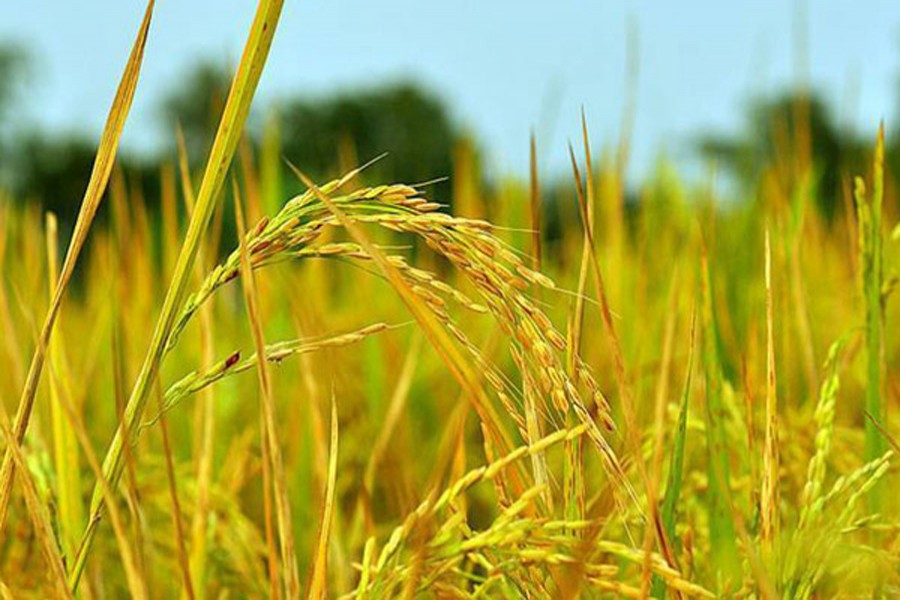Farmers are happy with satisfactory yield of newly harvested BRRI Dhan-48 in the region, including its vast Barind tract, in the current season.
Amidst this glowing atmosphere the farmers are now very busy harvesting the paddy variety in the region as part of their effort to mitigating the adverse impacts of climate change.
BRRI Dhan-48, a short duration and drought tolerant paddy variety innovated by Bangladesh Rice Research Institute (BRRI) for Aush season, has gradually been gaining popularity among farmers in the Barind tract for the last couple of years.
“I got 22 mounds of paddy per bigha through cultivating the variety on seven bighas of land this year,” said Shafiul Alam, 39, a farmer of Matikata village under Godagari upazila in the district.
He, however, could get hardly 10 mounds of paddy per bigha if he cultivates Parija, a conventional variety of the region.
Sabiar Rahman, 58, another farmer of Pirijpur village under the same upazila, expressed his happiness over cultivating the variety saying its average yield is from 15 to 23 mounds per bigha.
He mentioned that the conventional parija variety is being replaced by the new variety which is a good sign for the region in terms of boosting yield.
All the government and non-government organisations concerned are promoting the variety in the Barind tract as effective means of addressing the adverse impact of climate change.
Under a project titled, ‘Integrated Water Resource Management (IWRM)’, around 1,000 volunteers are working in the Barind region to motivate farmers to promote water-saving crops like BRRI Dhan-48 paddy farming.
Barind Station of On-Farm Research Division (OFRD) under Bangladesh Agriculture Research Institute (BARI) has inserted the paddy variety into its four-crop based cropping pattern in a bid to lessen the gradually mounting pressure on underground water in the drought-prone area.
DASCOH Foundation and Swiss Red Cross are jointly implementing the project in 39 UPs and three pourasabhas in Rajshahi, Naogaon and Chapainawabganj districts with financial support from Swiss Agency for Development and Cooperation-SDC since 2015.
Dr Shakhawat Hossain, team leader of OFRD (Barind Station), said there has been an enormous prospect of bringing harvesting intensity coupled with increasing food production through a successful promotion of the Aush-Aman-Lentil-Mungbean cropping pattern.
To maintain sound soil health, it could be advisable to grow rice especially BRRI Dhan-48 using a different system in order to improve compatibility between monsoon rice and upland winter crops.
The newly innovated paddy variety has opened up a new door of enormous prospects of food security along with mitigating the crises of irrigation water.
It has been giving satisfactory yield with scanty rainfall and limited irrigation during the Aush season in the area. This would also go well with a shift in economic importance of the winter crops over monsoon rice.
“We are arranging training and other motivational programmes for the farmers to adopt the cropping pattern to boost agricultural production through the best use of modern technologies to feed the gradually increasing population,” he added.
Terming the development of the drought-tolerant varieties a demand of the time, Dr Hossain said that the variety has started contributing a lot to ensure food security.
Sharing their experiences, two female farmers – Anwara Parveen and Nazma Akhter – said that the BRRI Dhan-48 variety has brought enormous benefit for them in cultivating rice in drought prone rain-fed environment, reports BSS.
They urged the authorities concerned to remove the existing seed crisis of the variety to encourage more farmers towards cultivating the variety.
By virtue of early harvesting characteristics the variety supplements the farming of transplanted Aman and various Rabi crops like tomato, brinjal, mustard and vegetables as the region is conventionally famous for farming these crops abundantly.


